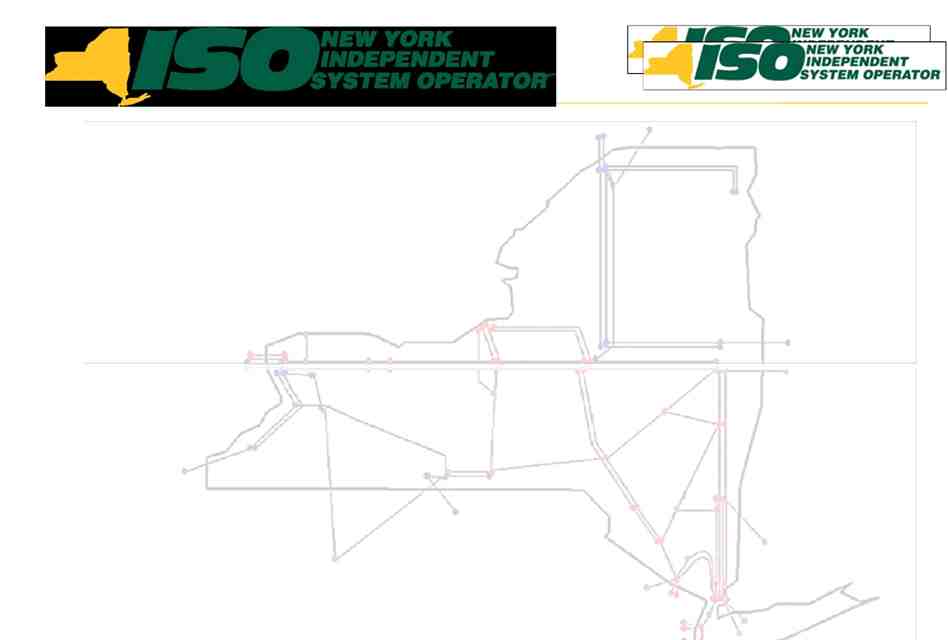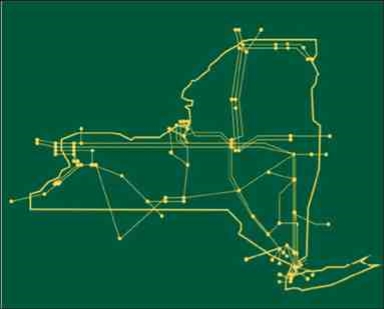
10 Krey Boulevard Rensselaer, NY 12144
April 10, 2012
Submitted Electronically
Kimberly D. Bose
Secretary
Federal Energy Regulatory Commission 888 First Street, N.E.
Washington, D.C. 20426
Re: New York Independent System Operator, Inc. Submission of Presentation and
Talking Points for Requested Technical Conference;
Docket No. ER08-1281-010
Dear Ms. Bose:
Consistent with the representations in its April 3, 2012 Motion for Leave to Respond and Response, the New York Independent System Operator, Inc. (“NYISO”) submits the attached presentations for discussion at the Technical Conference that the NYISO has asked the Commission to schedule in the above Docket.
The NYISO submits the following documents:
1.this transmittal letter;
2.The NYISO’s technical conference presentation (“Attachment I”);
3.Dr. David Patton’s technical conference talking points, presented on behalf of
Potomac Economics, the NYISO’s external Market Monitoring Unit (“Attachment II”); and
4.PJM Interconnection, LLC’s technical conference talking points (“Attachment
III”).
As the NYISO explained in its March 30, 2012 Request to Convene On-the-Record Technical Conference (“Request”), the NYISO seeks an opportunity to discuss the attached presentations with Commission Staff and to obtain Commission Staff guidance regarding the NYISO’s compliance proposal.
Kimberly D. Bose, Secretary April 10, 2012
Page 2
The NYISO respectfully requests that the Commission (i) convene the technical
conference that the NYISO’s Request asked the Commission to convene, and (ii) grant the NYISO an extension of time to permit the NYISO to submit its compliance filing 30 days after the requested technical conference is held.
Respectfully submitted,
/s/ Alex M. Schnell
Robert E. Fernandez, General Counsel Alex M. Schnell
New York Independent System Operator, Inc.
CERTIFICATE OF SERVICE
I hereby certify that I have this day served the foregoing document upon each person designated on the official service list compiled by the Secretary in this proceeding in accordance with the requirements of Rule 2010 of the Commission Rules of Practice and Procedure, 18 C.F.R. § 385.2010.
Dated at Rensselaer, New York this 10th day of April, 2012.
/s/ Joy A. Zimberlin
Joy A. Zimberlin
New York Independent System Operator, Inc.
10 Krey Boulevard
Rensselaer, NY 12144
Tel: (518) 356-6207
Fax: (518) 356-7678
E-mail: jzimberlin@nyiso.com
ATTACHMENT I
Interface Pricing
Presentation For Technical Conference
Presented by: Robert Pike,
Director of Market Design
New York Independent System Operator, Inc.


Interface Pricing
Robert Pike
Director of Market Design
New York Independent System Operator
FERC Technical Conference
April __, 2012
© 2011 New York Independent System Operator, Inc. All Rights Reserved.


Topics Addressed
Purpose of Presentation
NYISO Will Submit Proposed Tariff
Revisions
Goal of Interface Pricing
NYISO Will Use Non-Conforming Mode
Explanation of Non-Conforming Mode
Discuss Need for and Benefits of Path
Validation
© 2011 New York Independent System Operator, Inc. All Rights Reserved.


Purpose of Presentation
The NYISO requested this technical
conference to seek guidance from
Commission Staff regarding whether a
NYISO compliance filing that includes the
elements described in this presentation will
satisfy the requirements of the
Commission’s March 15 Order in Dkt.
ER08-1281-010
© 2011 New York Independent System Operator, Inc. All Rights Reserved.


Tariff Filing
The NYISO understands that FERC expects
it to submit Tariff revisions to incorporate
the interface pricing rules into the NYISO’s
Tariffs
NYISO is not seeking guidance regarding
the Commission’s instruction to submit
Tariff revisions, and intends to submit
proposed Tariff rules in its compliance
filing
© 2011 New York Independent System Operator, Inc. All Rights Reserved.


Conceptual Agreement
The goal of ISO/RTO interface pricing is to set
prices and determine schedules in a manner
that is consistent with how power actually
flows.
Use network impedance based distribution factors
Incorporate system topology changes (outages)
Use tag-based source/sink identification
Different market designs require different
implementations to achieve this common
goal.
© 2011 New York Independent System Operator, Inc. All Rights Reserved.


Non-Conforming Mode
NYISO’s Tariff revisions will propose to
implement non-conforming mode
NYISO is discussing the appropriate method of
reflecting the operation of the Ontario/Michigan
PARs with PJM and MISO
• If the Ontario/Michigan PARs successfully conform actual power flows to schedules, the non-conforming mode will not accurately reflect expected or actual power flows
• NYISO may propose to use a “sliding scale” approach,
rather than the binary conforming/non-conforming modes
© 2011 New York Independent System Operator, Inc. All Rights Reserved.


Non-Conforming Mode
How it works
Distribution factors are used to determine interface
prices based on the current or forecast topology of
the transmission system, including forced and
scheduled transmission outages
Evaluate expected power flows based upon a
proxy bus model representation of injections /
withdrawals
© 2011 New York Independent System Operator, Inc. All Rights Reserved.


Non-Conforming Mode
How it works
Does not directly use actual telemetered flows in
the determination of prices
• Where necessary to align prices with actual flows, NYISO weights specific line flows in the development of proxy
bus prices
• NYISO and PJM both use expected power flows in their pricing
NYISO uses the source/sink from the NERC tag to
define the source/sink area of a transactions and to
represent the distribution of power flows
© 2011 New York Independent System Operator, Inc. All Rights Reserved.


Path Validation
Validates that the bidding/scheduling entity has
represented the transaction to the NYISO in the
manner that is consistent with both the NERC e-Tag
information, and how the power will actually flow
Tag tells NYISO where the power is flowing from/to, just as it
does for PJM.
Tag information that exactly matches the NERC e-Tag must
be provided to the NYISO at the time a bid is submitted,
including the source and sink balancing authorities
Based upon the source/sink balancing authorities provided
NYISO validates that the bidder has presented the transaction
in a manner consistent with how the power will actually flow
© 2011 New York Independent System Operator, Inc. All Rights Reserved.


Path Validation
The NYISO invalidates the bid/offer for any
transaction when the tag and the bid are not
aligned
This requirement places the responsibility on the
MP to provide a valid bid and representative
source/sink
Prevents mismatches between scheduling and
pricing
© 2011 New York Independent System Operator, Inc. All Rights Reserved.


Benefits of Path Validation
Operational Benefits
Enhances regional reliability by promoting
consistency in expectation of flows, alignment of
contract and physical paths, and discourages
unnecessary loop flow
Facilitates accurate NERC directed interregional
coordination and checkout
• If NYISO, IESO, MISO and PJM all agree that 70-80% of
power circuitously scheduled from New York to serve
load in PJM flows over the direct interties between the two
Balancing Authorities, it would not make sense for NYISO
to coordinate its review of the reliability impacts of such a
circuitously scheduled NYISO to PJM transaction with
IESO
© 2011 New York Independent System Operator, Inc. All Rights Reserved.


Benefits of Path Validation
Market Benefits
Improves consistency between the scheduling
path and actual flows
Facilitates NYISO’s economic evaluation of
transaction schedules by permitting consistent
evaluation and pricing of ramp, ATC/TTC and
congestion
• NYISO’s economic evaluation of ATC, ramp limitations and congestion are performed simultaneously
• PJM separates into scheduling path reservations
(ATC/ramp) and expected power flows (congestion)
© 2011 New York Independent System Operator, Inc. All Rights Reserved.


Benefits of Path Validation, Cont.
Facilitates NYISO’s economic evaluation of
transaction schedules by permitting consistent
evaluation and pricing of ramp, ATC/TTC and
congestion (cont.)
• To facilitate simultaneous evaluation of ramp, ATC/TTC
and congestion, NYISO requires that the scheduling path be consistent with expected power flows, as defined by
the NERC tag
• The resulting LBMPs reflect the transactions that have been awarded and how the power is expected to flow
© 2011 New York Independent System Operator, Inc. All Rights Reserved.




The New York Independent System
Operator (NYISO) is a not-for-profit
corporation responsible for operating the state’s bulk electricity
grid, administering New York’s competitive wholesale electricity markets, conducting comprehensive long-term planning for the state’s
electric power system, and
advancing the technological
infrastructure of the electric system
serving the Empire State.
www.nyiso.com
© 2011 New York Independent System Operator, Inc. All Rights Reserved.
ATTACHMENT II
Interface Pricing
Talking Points for Technical Conference
Presented by: Dr. David Patton,
President
Potomac Economics, Ltd.
External Market Monitoring Unit for the
New York Independent System Operator, Inc.



TALKING POINTS FOR TECHNICAL CONFERENCE ON NYISO PROXY BUS PRICING
David B. Patton, Ph.D.
NYISO Market Monitoring Unit
April 10, 2012
Proxy Bus Pricing in the NYISO market design
• NYISO’s market design is unique in that it utilizes an economic evaluation to schedule
transactions, which includes allocating ramp and pricing congestion at its external interfaces.
•However, this uniqueness is beneficial and should not interfere with the external interface
pricing (“proxy bus pricing”).
Economic Principles Governing Proxy Bus Pricing
•Proxy bus pricing will affect how market participants schedule imports, exports, and wheels.
•To facilitate efficient scheduling, proxy bus pricing should be consistent with the expected
flows that will result from the schedule.
Practical Issues that Affect External Pricing and Scheduling Rules
• The source and sink of the power are important determinants of how the power will flow, but
there are substantial uncertainties caused by the following two factors.
- The source and sink are defined on a control area basis (because the marginal injection or
withdrawal may produce a very different flow effect than the control area average); and
- Transactions may be linked to other transactions that affect the ultimate source or sink (a
recognized issue).
- Nonetheless, proxy bus pricing based on the scheduled source/sink is consistent with the
economic principle.
•However, even though the pricing may be based on the scheduled source/sink, the scheduled
path cannot reasonably be ignored for two reasons.
- First, the RTOs must still manage external interface and ramp capability, which is affected
by the path over which the transaction is scheduled.
- Second, Phase Angle Regulators (“PARS”) can cause the expected power flows associated
with two transactions with identical sources and sinks, but different paths, to be very
different.
- Hence, the NYISO’s path validation is reasonable and does not conflict with source/sink
proxy bus pricing. Removing it would not provide any economic benefit.
• Because PARs affect the power flows throughout the eastern interconnect, the proxy bus
pricing regime should reflect these effects to be consistent with the economic principle described above.
- For example, when the OH/MI PARs are operational and significantly affecting the flows
around Lake Erie, those effects should be reflected in NYISO’s proxy bus prices.
- Likewise, because the scheduled path for a transaction may alter the PAR settings, NYISO
should consider how to incorporate the path information in its proxy bus pricing rather than
relying solely on the source and sink for the transaction.
Page 1
ATTACHMENT III
Interface Pricing
Talking Points for Technical Conference
Presented by: PJM Interconnection, LLC
PJM’s Technical Conference Talking Points
• Role of NERC e‐Tag in PJM’s external transaction evaluation process
o Modeling of injections and withdrawals in market software
Day‐Ahead
Real‐Time
• Proxy Buses
o Detailed explanation of how PJM calculates interface prices
o How PJM selects and uses proxy buses to price interchange
transactions to/from external balancing authorities
o How the proxy bus prices reflect the value of the energy associated
with interchange transactions to the PJM market




